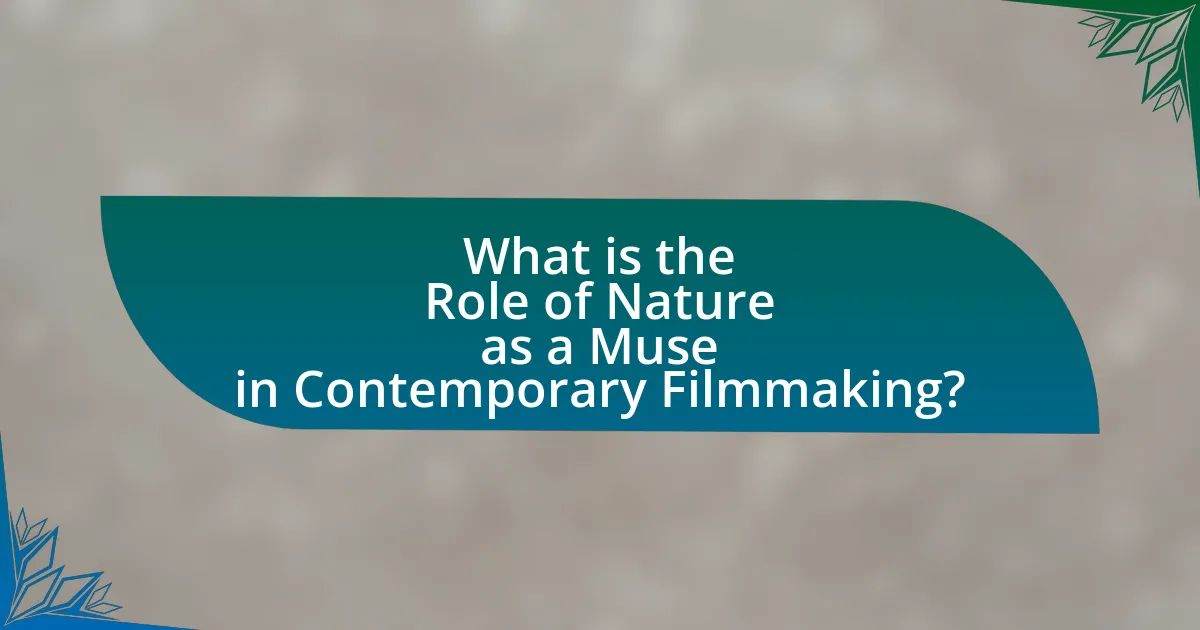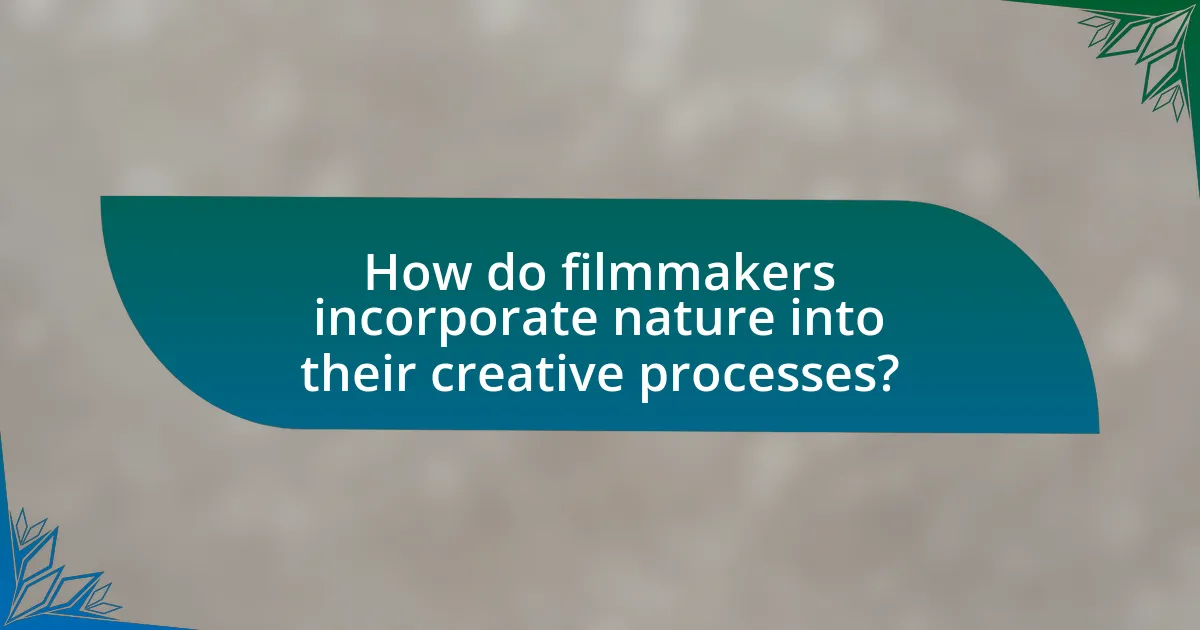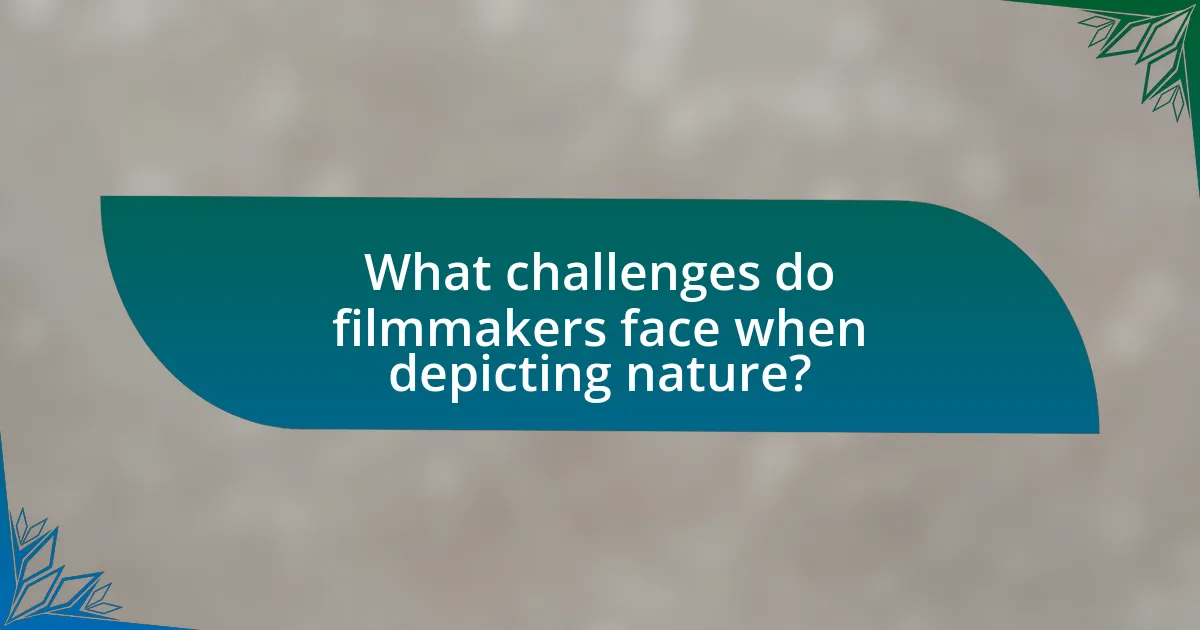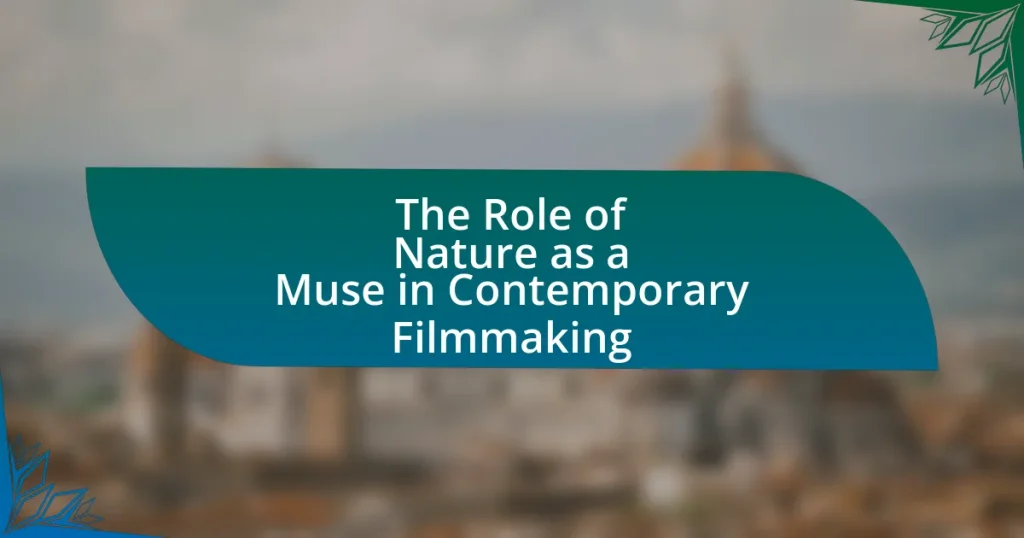The article examines the role of nature as a muse in contemporary filmmaking, highlighting its significance in inspiring themes, visuals, and narratives. It discusses how filmmakers utilize natural landscapes to evoke emotions, address environmental issues, and explore the human connection to the earth, with examples from films like “The Revenant” and “Into the Wild.” The article also explores the impact of nature on audience perception, the techniques filmmakers use to capture natural beauty, and the ethical considerations involved in depicting nature. Additionally, it addresses the challenges filmmakers face and the best practices for integrating nature into film narratives, emphasizing the importance of sustainability in the filmmaking process.

What is the Role of Nature as a Muse in Contemporary Filmmaking?
Nature serves as a significant muse in contemporary filmmaking by providing inspiration for themes, visuals, and narratives. Filmmakers often draw upon natural landscapes to evoke emotions, convey messages about environmental issues, and explore the human connection to the earth. For instance, films like “The Revenant” and “Into the Wild” utilize breathtaking natural settings to enhance storytelling and reflect characters’ internal struggles. This connection to nature not only enriches the visual experience but also resonates with audiences, fostering a deeper appreciation for the environment. The use of nature in film has been documented in studies, such as those by the American Film Institute, which highlight how natural elements can influence audience perception and emotional engagement.
How has nature influenced the themes in contemporary films?
Nature has significantly influenced the themes in contemporary films by serving as a backdrop that reflects human emotions and societal issues. Filmmakers often utilize natural landscapes to symbolize internal struggles, as seen in films like “Into the Wild,” where the wilderness represents freedom and self-discovery. Additionally, environmental themes have gained prominence, with movies such as “Avatar” highlighting the conflict between industrialization and nature, prompting audiences to consider ecological preservation. This trend is supported by the increasing number of films addressing climate change, such as “Chasing Ice,” which documents the impact of global warming on glaciers, thereby reinforcing the connection between nature and contemporary storytelling.
What specific elements of nature are commonly depicted in films?
Specific elements of nature commonly depicted in films include landscapes, water bodies, flora, and fauna. Landscapes such as mountains, forests, and deserts often serve as backdrops that enhance the narrative and emotional tone of a film. Water bodies, including oceans, rivers, and lakes, are frequently used to symbolize depth, tranquility, or turmoil. Flora, such as trees and flowers, can represent growth, beauty, or decay, while fauna, including animals, often symbolize various themes like freedom, companionship, or the struggle for survival. These elements are integral to storytelling, as they evoke emotions and set the atmosphere, making nature a vital component in contemporary filmmaking.
How do filmmakers interpret natural landscapes in their storytelling?
Filmmakers interpret natural landscapes by using them as visual metaphors that enhance narrative themes and character development. For instance, a desolate landscape may symbolize isolation or despair, while lush greenery can represent hope or renewal. This interpretation is evident in films like “The Revenant,” where the harsh wilderness reflects the protagonist’s struggle for survival, illustrating the relationship between character and environment. Additionally, filmmakers often employ cinematography techniques, such as wide shots, to emphasize the grandeur or menace of nature, thereby influencing audience emotions and perceptions. This approach is supported by studies showing that visual elements significantly impact storytelling effectiveness, as seen in the work of scholars like David Bordwell, who emphasizes the role of mise-en-scène in narrative construction.
Why do filmmakers choose nature as a source of inspiration?
Filmmakers choose nature as a source of inspiration because it provides a rich visual and thematic backdrop that enhances storytelling. Nature’s diverse landscapes, colors, and textures evoke emotions and symbolize various human experiences, making it a powerful tool for filmmakers. For instance, films like “Into the Wild” and “The Revenant” utilize natural settings to reflect characters’ internal struggles and journeys, demonstrating how the environment can mirror human emotions. Additionally, studies show that nature can influence audience perception and engagement, as natural imagery often resonates on a deeper psychological level, fostering a connection between the viewer and the narrative.
What emotional responses does nature evoke in audiences?
Nature evokes a range of emotional responses in audiences, including awe, tranquility, nostalgia, and inspiration. These emotions arise from the beauty and complexity of natural landscapes, which can elicit feelings of wonder and peace. Research indicates that exposure to nature can reduce stress and enhance mood, as demonstrated in a study published in the journal “Environmental Science & Technology,” where participants reported lower levels of anxiety after spending time in natural settings. Additionally, nature often serves as a powerful symbol in filmmaking, representing themes of renewal and connection, further deepening the emotional impact on viewers.
How does nature contribute to the visual aesthetics of films?
Nature significantly enhances the visual aesthetics of films by providing diverse and striking landscapes that evoke emotions and set the tone. Cinematographers often utilize natural elements such as mountains, forests, and oceans to create visually compelling scenes that resonate with audiences. For instance, films like “The Revenant” and “Into the Wild” showcase breathtaking natural settings that not only serve as backdrops but also reflect the characters’ journeys and inner struggles. The use of natural light and organic textures further enriches the visual experience, making scenes more immersive and relatable. Studies have shown that viewers often respond positively to natural imagery, associating it with beauty and tranquility, which filmmakers leverage to enhance storytelling and emotional impact.

How do filmmakers incorporate nature into their creative processes?
Filmmakers incorporate nature into their creative processes by using natural landscapes and elements as visual storytelling tools, which enhance the emotional and thematic depth of their films. For instance, directors often choose specific locations that reflect the mood or character arcs, such as the use of vast deserts to symbolize isolation or lush forests to represent growth and renewal. Additionally, filmmakers may draw inspiration from the sounds and movements of nature, integrating these elements into the film’s score or sound design to create a more immersive experience. This practice is supported by studies showing that natural settings can evoke stronger emotional responses from audiences, thereby reinforcing the narrative.
What techniques do filmmakers use to capture the essence of nature?
Filmmakers use techniques such as aerial cinematography, time-lapse photography, and natural soundscapes to capture the essence of nature. Aerial cinematography allows filmmakers to showcase vast landscapes and intricate details from above, providing a unique perspective that emphasizes the scale and beauty of natural environments. Time-lapse photography captures the gradual changes in nature, such as blooming flowers or moving clouds, effectively conveying the passage of time and the dynamic qualities of the natural world. Additionally, incorporating natural soundscapes enhances the immersive experience, allowing audiences to feel the ambiance of the environment, whether it be rustling leaves or flowing water. These techniques collectively create a vivid representation of nature, engaging viewers and evoking emotional responses.
How does location scouting impact the portrayal of nature in films?
Location scouting significantly impacts the portrayal of nature in films by determining the visual authenticity and emotional resonance of natural settings. The selection of specific locations influences how filmmakers capture the essence of nature, shaping the audience’s perception and connection to the environment depicted. For instance, films shot in authentic natural landscapes, such as the breathtaking fjords of Norway in “The Secret Life of Walter Mitty,” enhance the narrative by providing a genuine backdrop that reflects the film’s themes of adventure and self-discovery. This authenticity can evoke stronger emotional responses from viewers, as they are immersed in real-world environments that resonate with the film’s message.
What role does cinematography play in showcasing natural beauty?
Cinematography plays a crucial role in showcasing natural beauty by employing techniques such as framing, lighting, and camera movement to enhance visual aesthetics. Through careful composition, cinematographers can highlight the intricate details of landscapes, flora, and fauna, making them more visually appealing. For instance, the use of golden hour lighting can create a warm, inviting atmosphere that accentuates the colors and textures of nature. Additionally, dynamic camera movements, such as sweeping aerial shots, can capture the vastness and grandeur of natural settings, evoking emotional responses from the audience. This approach is evident in films like “The Revenant,” where Emmanuel Lubezki’s cinematography vividly portrays the beauty and brutality of the wilderness, reinforcing the film’s themes.
How do different genres utilize nature as a muse?
Different genres utilize nature as a muse by reflecting their thematic elements and emotional tones through natural landscapes and phenomena. For instance, in drama, nature often symbolizes internal conflict or character development, as seen in films like “Into the Wild,” where the wilderness represents freedom and self-discovery. In horror, nature can evoke fear and isolation, exemplified by “The Blair Witch Project,” where the forest becomes a menacing character. In romance, natural settings enhance emotional connections, as demonstrated in “A Walk in the Clouds,” where vineyards symbolize love and growth. These examples illustrate how filmmakers leverage nature to deepen narrative impact and resonate with audiences.
What are the unique approaches to nature in documentaries versus fiction films?
Documentaries approach nature by emphasizing realism and factual representation, often showcasing the environment and wildlife through observational techniques and scientific narratives. For instance, documentaries like “Planet Earth” utilize high-definition cinematography to capture authentic behaviors and ecosystems, providing educational insights and raising awareness about conservation issues. In contrast, fiction films often use nature as a backdrop or thematic element, employing artistic interpretation and narrative devices to evoke emotions or symbolize human experiences. Films such as “The Revenant” utilize natural landscapes to enhance storytelling, creating a visceral connection between characters and their environment. This distinction highlights how documentaries prioritize factual accuracy while fiction films focus on emotional resonance and narrative depth.
How does the representation of nature differ across cultural contexts in filmmaking?
The representation of nature in filmmaking varies significantly across cultural contexts, reflecting differing values, beliefs, and relationships with the environment. For instance, in Western cinema, nature is often depicted as a backdrop for human drama or a source of conflict, emphasizing themes of conquest and exploitation, as seen in films like “Into the Wild.” In contrast, Indigenous filmmaking frequently portrays nature as a living entity, integral to identity and spirituality, exemplified by works such as “Smoke Signals,” where the landscape is intertwined with cultural narratives. This divergence highlights how cultural perspectives shape the portrayal of nature, influencing audience perceptions and emotional connections.

What challenges do filmmakers face when depicting nature?
Filmmakers face several challenges when depicting nature, primarily related to environmental unpredictability, technical limitations, and ethical considerations. Environmental unpredictability includes factors such as weather changes and wildlife behavior, which can disrupt shooting schedules and affect the visual outcome. Technical limitations involve the need for specialized equipment to capture high-quality images of natural landscapes, which can be costly and require skilled operators. Ethical considerations arise from the responsibility to portray nature accurately and sensitively, avoiding exploitation or misrepresentation of ecosystems. These challenges necessitate careful planning and adaptability to ensure that filmmakers can effectively convey the beauty and complexity of nature in their work.
How do environmental concerns affect filmmaking practices?
Environmental concerns significantly influence filmmaking practices by prompting the industry to adopt sustainable methods and reduce ecological footprints. Filmmakers increasingly prioritize eco-friendly production techniques, such as using renewable energy sources, minimizing waste, and selecting locations that align with conservation efforts. For instance, the production of the film “Before the Flood” involved extensive collaboration with environmental organizations to raise awareness about climate change, demonstrating a direct link between filmmaking and environmental advocacy. Additionally, the Green Production Guide provides resources for filmmakers to implement sustainable practices, highlighting the industry’s shift towards environmental responsibility.
What are the ethical considerations filmmakers must address when using natural settings?
Filmmakers must address the ethical considerations of environmental impact, cultural sensitivity, and wildlife protection when using natural settings. Environmental impact involves assessing how filming activities may disrupt ecosystems, such as damaging flora or altering habitats. Cultural sensitivity requires filmmakers to respect the traditions and rights of indigenous communities that may inhabit or have historical ties to the filming locations. Wildlife protection mandates that filmmakers avoid disturbing animal habitats and adhere to regulations that safeguard endangered species. These considerations are crucial for responsible filmmaking that honors both nature and local communities.
How can filmmakers balance artistic vision with environmental sustainability?
Filmmakers can balance artistic vision with environmental sustainability by integrating eco-friendly practices into their production processes. This can include using sustainable materials for sets, minimizing waste through recycling and composting, and opting for energy-efficient lighting and equipment. For instance, the production of the film “The Revenant” implemented a zero-waste policy, which significantly reduced its environmental impact while still achieving its artistic goals. By prioritizing sustainability, filmmakers not only preserve the natural environments that inspire their work but also set a precedent for responsible filmmaking in the industry.
What are the best practices for integrating nature into film narratives?
The best practices for integrating nature into film narratives include using natural settings to enhance storytelling, employing visual symbolism related to nature, and incorporating soundscapes that reflect the environment. Natural settings can serve as backdrops that influence character development and plot progression, as seen in films like “Into the Wild,” where the Alaskan wilderness plays a crucial role in the protagonist’s journey. Visual symbolism, such as the use of weather or landscapes to mirror emotional states, can deepen audience engagement; for example, stormy weather often signifies turmoil. Additionally, soundscapes that include natural sounds, like birdsong or rustling leaves, can create an immersive experience, as demonstrated in documentaries like “Planet Earth,” which effectively use audio to connect viewers with nature. These practices not only enrich narratives but also foster a greater appreciation for the environment.
How can filmmakers effectively convey messages about nature through their work?
Filmmakers can effectively convey messages about nature through visual storytelling, sound design, and thematic elements. By utilizing stunning cinematography that captures the beauty and fragility of natural landscapes, filmmakers can evoke emotional responses and raise awareness about environmental issues. For instance, documentaries like “Our Planet” showcase diverse ecosystems and the impact of climate change, effectively communicating the urgency of conservation. Additionally, soundscapes that incorporate natural sounds enhance the immersive experience, allowing audiences to connect more deeply with the subject matter. Thematic narratives that highlight the relationship between humans and nature, such as in “Into the Wild,” further reinforce the message by illustrating the consequences of disconnection from the environment.
What resources are available for filmmakers seeking to explore nature as a muse?
Filmmakers seeking to explore nature as a muse can access a variety of resources, including nature documentaries, environmental organizations, and online platforms that provide footage and soundscapes. Nature documentaries, such as “Planet Earth” and “Our Planet,” offer visual inspiration and insights into natural ecosystems, while organizations like the National Geographic Society provide educational materials and grants for projects focused on nature. Additionally, platforms like Shutterstock and Adobe Stock offer extensive libraries of nature footage and sounds that filmmakers can utilize to enhance their storytelling. These resources collectively support filmmakers in capturing the beauty and complexity of nature, fostering creativity and awareness in their work.


